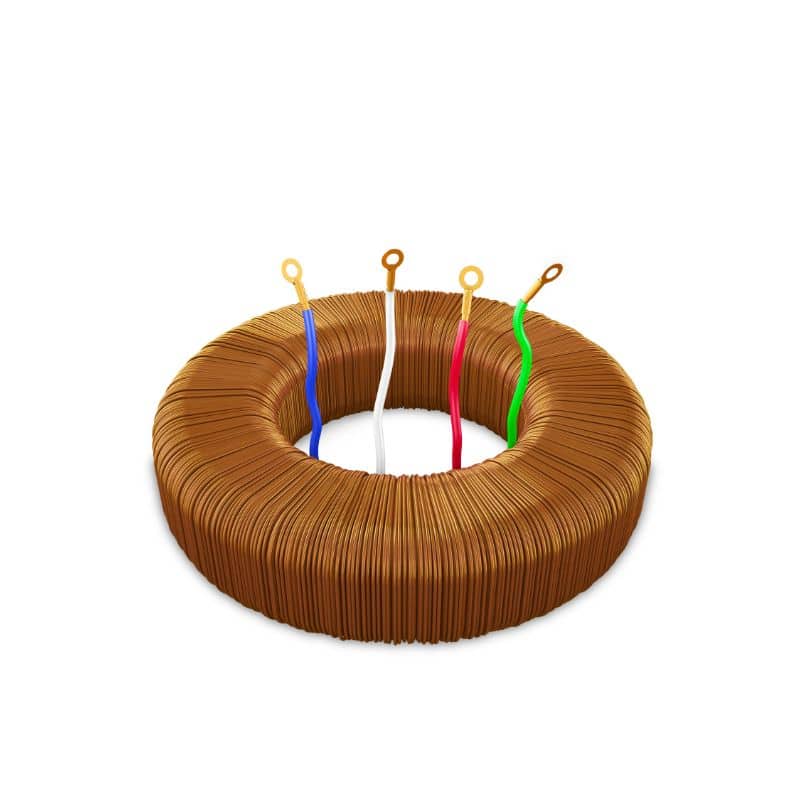A toroidal conductivity sensor (also known as an inductive or electrode-free conductivity sensor) is a sensor used to measure the conductivity of a solution where the sensing element is not in direct contact with the solution. This design has a significant advantage over conventional sensors and is particularly suitable for applications involving highly contaminating, corrosive chemicals or scaling liquids.

Two Types of Conductivity
Contact Conductivity

Contact conductivity sensors measure the conductivity of a solution by directly contacting the solution through two electrodes. This type of sensor is based on Ohm’s law, where an electric current enters the solution through the electrodes and the conductivity of the solution is calculated by measuring the resistance between the two electrodes.
Advantages
High accuracy: Suitable for measurement of low conductivity solutions.
Fast response: Contact conductivity sensor responds quickly to changes in electrical conductivity.
Disadvantages
- Susceptible to contamination and corrosion: The electrode is in direct contact with the solution and is susceptible to contamination, scaling or corrosion, especially in wastewater treatment or environments with high chemical concentrations.
- Frequent maintenance: The electrode needs to be cleaned and maintained regularly to ensure the accuracy of the measurement.
Application
Suitable for measurement of pure water or low conductivity liquids, such as pharmaceuticals, semiconductor manufacturing, laboratory analysis, etc.
Toroidal Conductivity Sensor
Toroidal coils can be thought of as circular solenoids used in electrical circuits, and can be used as inductors requiring large inductance at low frequencies. Toroidal conductivity sensors utilize two induction coils for conductivity measurements without the need for electrodes to be in direct contact with the solution. The sensor induces a current in the solution by generating an alternating magnetic field through one induction coil, and the other coil detects this current to calculate the conductivity of the solution.

Advantages
- Corrosion and contamination resistance: The sensor does not come into direct contact with the liquid, making it particularly suitable for highly contaminated, corrosive or scale-prone liquids.
- Low Maintenance Requirements: low maintenance costs as there are no electrodes in contact with the solution and contamination or scaling is less of an issue.
Disadvantages
Not suitable for low conductivity solutions: for solutions with very low conductivity, the sensing signal may not be strong enough, resulting in less accurate measurements.
Application
Suitable for high conductivity solutions, such as sewage, salt solutions, acid and alkali solutions, etc. It is widely used in chemical, food and beverage, seawater desalination and other industries.
While ring sensors work similarly to contact sensors, ring sensors are more durable and can be used in highly contaminated water.
Comparison of Two Toroidal Conductivity Sensor
| Characteristics | Contact Conductivity | Toroidal Conductivity Sensor |
| Working Principle | Electrodes in direct contact with the solution | Non-Contact Induction Coils |
| Application | Low conductivity solution, pure water measurement | High conductivity solutions, etching or contaminated liquids |
| Maintenance Requirements | Frequent cleaning of electrodes | Highly resistant to contamination |
| Corrosion Resistance | Susceptible to corrosion | Highly corrosion resistant |
| Measurement accuracy | High | High |
Contact conductivity sensors are suitable for high accuracy measurements in low conductivity or pure water environments, but require more maintenance.
Toroidal conductivity sensors are more suitable for highly contaminated, corrosive or scaling liquids, although accuracy in low conductivity solutions may be inadequate.
Liquids for Toroidal Conductivity Sensor Measurement
- Sewage and industrial wastewater
- Highly saline solutions (e.g. seawater, brine)
- Strong acid and alkali solutions
- Liquids in the food and beverage industry
- Electroplating solutions
- Chemical solutions
Electrode Constants for Toroidal Conductivity Sensors
Toroidal conductivity sensors (inductive conductivity sensors) differ from conventional contact conductivity sensors in that they do not rely directly on electrodes and therefore do not have an “electrode constant” in the traditional sense. In contact conductivity sensors, the cell constant is the ratio of the distance between the two electrodes to the surface area of the electrodes and is used to calibrate the measurement.
Differences Between Solenoids and Toroids
Both solenoids and toroidal coils work on the basis of electromagnetism. This is one of the similarities between the two. However, there are differences between solenoids and toroidal coils because for a given toroidal coil, the amount of current is greater than that of a solenoidal coil, and therefore they have the same dimensions.
Summary
The Toroidal Conductivity Sensor has become the conductivity monitoring device of choice for many industries due to its high durability, maintenance-free design and ability to withstand harsh conditions. In the future, as technology continues to advance, the toroidal conductivity sensor will be used in even more applications, helping to optimize processes and control quality in even more industries. If you are facing a highly corrosive or scaling process environment, the Toroidal Conductivity Sensor is a reliable option to consider.
As a well-known brand in the industry, Apure has been focusing on the use of advanced technology and high-quality materials, capable of long-term stable operation in a variety of harsh industrial environments. We offer, in addition to conductivity instruments, water quality monitoring for testing various values, flow meters, level measurement, pressure measurement, temperature measurement and ozone generators. Welcome to click on the website to contact us to provide you with high-precision and high-stability solutions.
